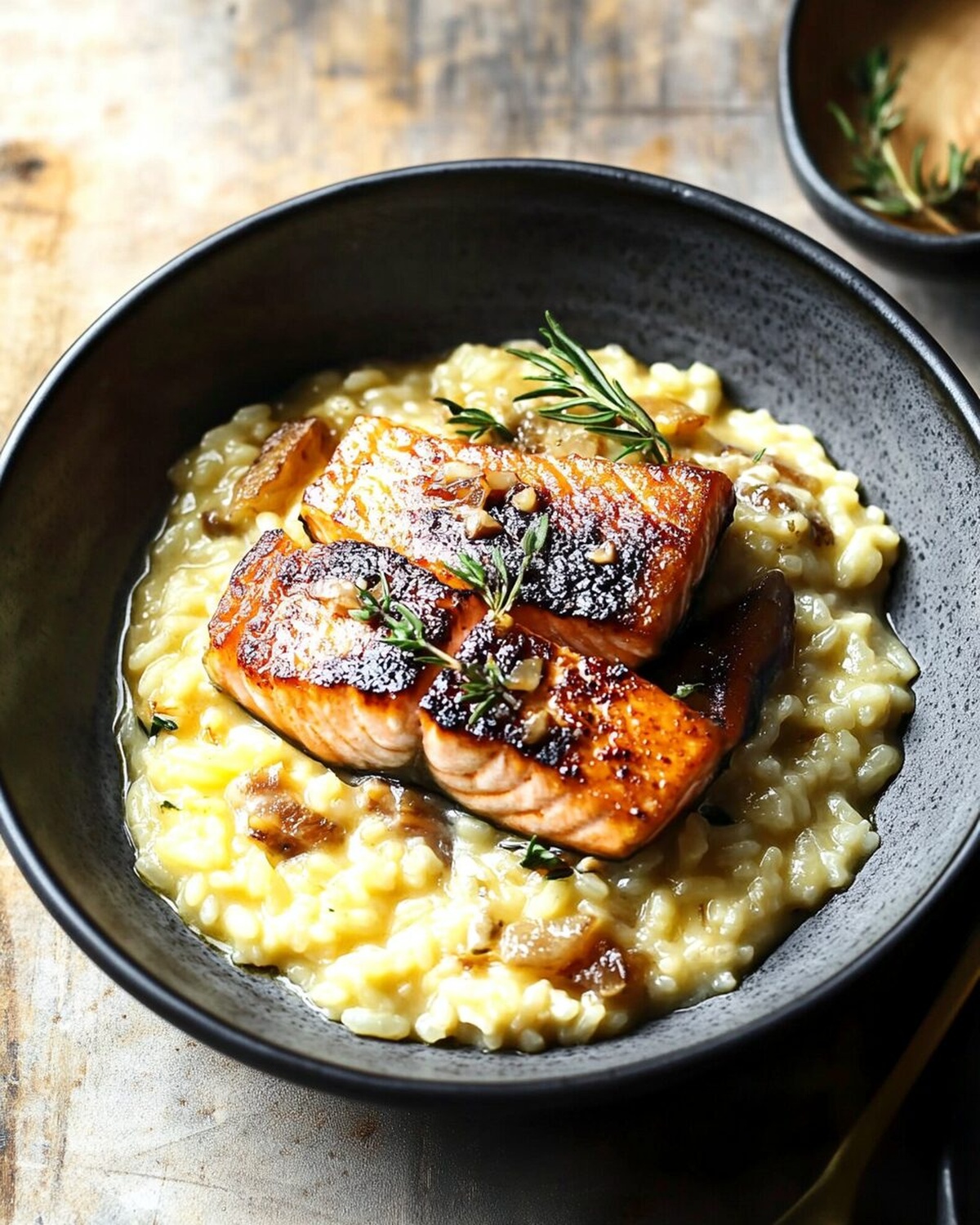Dreamy Japanese-Style Risotto with Seared Salmon Recipe
Crafting a japanese-style risotto with salmon brings unexpected culinary magic to your kitchen.
Waves of creamy arborio rice mingle with delicate ocean flavors.
Japanese ingredients like mirin and kombu create surprising depth in this fusion dish.
Tender salmon pieces crown the risotto with their rich, silky texture.
Gentle cooking techniques transform simple ingredients into an elegant meal.
Each bite promises a sophisticated blend of Italian technique and Japanese umami.
You’ll be amazed how these cultural cuisines dance together on one plate.
Prepare to impress with this stunning, restaurant-worthy creation.
Why Japanese-Style Risotto With Seared Salmon Feels So Unique
Ingredients List For Japanese-Style Risotto With Seared Salmon
Main Ingredients:Aromatic Vegetables:Seasoning and Finishing Ingredients:How To Make Japanese-Style Risotto With Seared Salmon
Step 1: Prepare Salmon Marinade
Create a flavorful marinade by mixing soy sauce, white wine, and brown sugar in a shallow dish. Gently coat salmon fillets in the mixture, ensuring even coverage.
Let the salmon absorb the flavors while preparing other ingredients.
Step 2: Chop Vegetables
Step 3: Roast Mushrooms
Heat olive oil in a heavy-bottomed skillet over high heat.
Add mushrooms and cook until they release moisture. Continue cooking until mushrooms turn golden brown.
Splash in soy sauce and cook for an additional minute. Remove mushrooms from the skillet and set aside.
Step 4: Build Risotto Foundation
Reduce heat to medium-low. Add olive oil to the same skillet.
Sauté celery, onion, and garlic until fragrant and slightly translucent. Introduce rice, stirring to toast and coat each grain.
Pour white wine into the skillet, scraping up any browned bits from the bottom. Allow the wine to simmer and reduce.
Step 5: Create Creamy Risotto
Gradually add chicken broth, two ladles at a time. Stir continuously, allowing each addition to be mostly absorbed before adding more.
Continue this process for approximately 15 minutes until rice reaches near-al dente consistency. Fold in the roasted mushrooms.
Dissolve miso paste in hot broth and incorporate into the risotto. Cook for an additional 5 minutes, adding more broth as needed to maintain creamy texture.
Step 6: Sear Salmon to Perfection
Heat combination of olive oil and butter in a nonstick skillet over medium-high heat. Place salmon fillets in the pan and cook for 3-4 minutes on each side.
Aim for a caramelized exterior and flaky interior.
Step 7: Plate and Garnish
Spoon risotto onto serving plates.
Carefully place seared salmon on top. Sprinkle with freshly ground black pepper, chopped chives, and toasted sesame seeds.
Serve immediately and enjoy the fusion of Japanese and Italian culinary techniques.
Smart Tips For Japanese-Style Risotto With Seared Salmon
Ways To Tweak Japanese-Style Risotto With Seared Salmon
What Goes Well With Japanese-Style Risotto With Seared Salmon
How To Store Japanese-Style Risotto With Seared Salmon Properly
FAQs About Japanese-Style Risotto With Seared Salmon
This Japanese-style risotto incorporates unique Asian ingredients like miso paste, soy sauce, and shiitake mushrooms, giving it a distinctly umami flavor profile compared to classic Italian versions.
Arborio rice is crucial for risotto’s creamy texture. While you could use other short-grain rice, the starch content and cooking method won’t produce the same rich, creamy consistency that defines a traditional risotto.
The salmon is done when it’s caramelized on the outside, flaky when gently pressed with a fork, and has a light pink center. Overcooking will make it dry and tough, so watch it closely during searing.
Print
Japanese-Style Risotto with Seared Salmon Recipe
- Total Time: 45 minutes
- Yield: 4 1x
Description
Delightful Japanese-style risotto with seared salmon brings together creamy Arborio rice and perfectly cooked fish in a harmonious culinary fusion. Umami-rich ingredients and precise cooking techniques create a memorable dining experience that transports palates straight to coastal Japan.
Ingredients
Main Ingredients:
- 4 skinless salmon fillets
- 1 cup sushi rice (or Arborio)
- 10.5 ounces (298 grams) shiitake mushrooms, torn into pieces
- 5 cups hot chicken broth (or dashi)
Aromatics and Seasonings:
- 1 small yellow onion, diced
- 1 celery stalk, diced
- 1 garlic clove, minced
- 1 tablespoon white miso paste
- 1 tablespoon low-sodium soy sauce
- 5 tablespoons low-sodium soy sauce
- 1/4 cup dry white wine (or sake)
- 1 tablespoon dry white wine
- 1 teaspoon brown sugar
- Black pepper, to taste
Cooking Fats and Garnish:
- 3 tablespoons olive oil, divided
- 1 tablespoon olive oil
- 1 tablespoon unsalted butter
- Chives, for garnish
- Sesame seeds, for garnish
Instructions
- Immerse salmon fillets in a zesty marinade of soy sauce, white wine, and brown sugar for enhanced flavor profiles. Allow to rest while preparing other components.
- Deconstruct shiitake mushrooms by hand, creating rustic texture. Finely mince celery, onion, and garlic for uniform distribution throughout the dish.
- Caramelize mushrooms in a scorching skillet with olive oil, creating deep umami notes. Once golden and moisture-evaporated, deglaze with soy sauce and remove from pan.
- Reduce heat to medium-low. Sweat aromatics (celery, onion, garlic) until fragrant, approximately 2 minutes. Introduce rice, toasting for 1 minute to develop nutty undertones. Splash white wine, allowing it to simmer and release fond from skillet bottom.
- Incrementally introduce chicken broth, stirring consistently for 15-18 minutes. Rice should approach al dente consistency. Reintegrate mushrooms and dissolve miso paste into hot broth, creating creamy complexity. Continue cooking until risotto reaches desired consistency.
- Simultaneously prepare salmon in a separate nonstick skillet. Sear at medium-high temperature (375°F) for 3-4 minutes per side, achieving golden caramelization and flaky texture.
- Assemble by nestling salmon atop risotto. Elevate presentation with freshly cracked black pepper, delicate chive snippets, and toasted sesame seeds for textural contrast.
Notes
- Marinating in advance helps infuse deeper umami flavors into the salmon, enhancing its taste profile.
- Toast rice thoroughly to develop a nutty, complex flavor before adding liquid, which prevents mushiness and creates a better texture.
- Use low-sodium chicken broth to control salt levels, especially when incorporating soy sauce and miso paste which are naturally salty.
- For gluten-free adaptation, replace soy sauce with tamari and ensure miso paste is certified gluten-free.
- Prep Time: 15 minutes
- Cook Time: 30 minutes
- Category: Dinner, Lunch
- Method: Sautéing
- Cuisine: Japanese
Nutrition
- Serving Size: 4
- Calories: 550
- Sugar: 3 g
- Sodium: 600 mg
- Fat: 30 g
- Saturated Fat: 7 g
- Unsaturated Fat: 20 g
- Trans Fat: 0 g
- Carbohydrates: 54 g
- Fiber: 2 g
- Protein: 28 g
- Cholesterol: 80 mg


Mia Thompson
Pastry Chef & Content Creator
Expertise
Education
Portland Community College – Baking and Pastry Arts Program
Specialized in artisanal bread, seasonal desserts, and sustainable baking methods.
National University of Natural Medicine – Bachelor of Science in Nutrition (BScN)
Focused on “Food as Medicine” philosophy, with core threads in nutrition.
Mia’s love affair with baking began in her grandmother’s kitchen, where sneaking spoonfuls of batter first sparked her curiosity. She refined her skills through Portland Community College’s Baking and Pastry Arts Program and her expertise at the National University of Natural Medicine, earning a B.Sc. in Nutrition.
At The Scrumptious Pumpkin, Mia reimagines classics with effortless seasonal treats, healthier twists on old favorites, and playful confections that feel like pure joy. Beyond the oven, she nurtures her urban garden, forages local ingredients around Portland, and leads hands‑on nutrition workshops for her community.